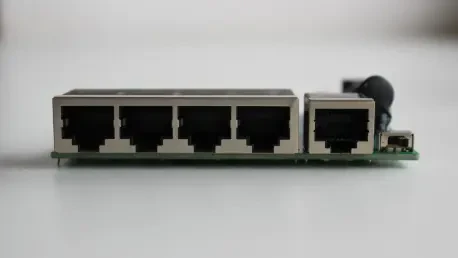The Ethernet module market is experiencing unprecedented growth, driven by the rise in demand for high-speed internet, the increasing adoption of Internet of Things (IoT) devices, and the shift towards cloud-based solutions. From 2025 to 2032, the market is poised to grow from USD 41.35 billion to USD 82.96 billion, with a strong compound annual growth rate of 9.1%. The technological advancements in networking and the rollout of fifth-generation communication networks worldwide are placing Ethernet modules at the heart of modern digital infrastructures. Key industries, including telecommunications, data centers, and smart manufacturing, rely heavily on these modules, highlighting their importance in both existing and emerging technologies.
Key Drivers of Growth
The burgeoning rise in data, spurred by increased video content consumption and a surge in connected devices, underscores the need for efficient data transmission solutions. Ethernet modules are critical in ensuring high bandwidth and low latency, key factors for maintaining optimal performance in data-intensive applications. As video streaming becomes more prevalent and enterprise applications more sophisticated, the demand for these high-speed networking solutions continues to rise significantly. This increased demand aligns perfectly with the growth of Ethernet modules, which are routinely deployed to handle massive data flow effectively, eliminating bottlenecks and optimizing overall network performance.
In tandem with soaring data traffic, there’s a marked shift towards cloud computing as enterprises move their workloads off-premises. The seamless integration between onsite network equipment and cloud services relies heavily on Ethernet modules’ ability to provide secure, high-performance connectivity. This integration is vital for maintaining data integrity during transmission and ensuring businesses can swiftly adapt to cloud environments. As the cloud market expands, so does the necessity for reliable Ethernet solutions that facilitate smooth and efficient cloud-based operations. These factors collectively highlight the growing reliance on Ethernet modules as pivotal components in establishing a robust cloud infrastructure.
Technological Advancements and Innovations
Technological advancements are further bolstering the Ethernet module market. The development of 400G Ethernet and breakthroughs like Power over Ethernet (PoE) enable better performance and energy efficiency, reducing operational costs and complexities. These innovations allow for higher speed capabilities without compromising on reliability, making Ethernet modules an attractive proposition for organizations looking to enhance their networking infrastructure. The drive for technological improvements is also echoed in emerging low-latency protocols, which are crucial for applications demanding instant data processing and transmission, thereby cementing Ethernet modules’ position as fundamental enablers of modern communication networks.
Government initiatives supporting smart infrastructure projects, particularly within urban planning and transportation systems, are propelling the demand for Ethernet modules. As cities worldwide transition towards smart and digital frameworks, the need for efficient, fast networking increases. Ethernet modules offer the scalability and adaptability necessary to support these large-scale projects, ensuring consistent and reliable data transmission across diverse platforms and applications. By enabling smooth interconnectivity within and between smart city infrastructures, these modules play a crucial role in facilitating advanced urban mobility and data-driven public services, further driving their adoption across various government-backed initiatives.
Market Segmentation and Regional Insights
Strong market segmentation underscores the extensive reach and versatility of Ethernet modules. Their applications span multiple dimensions, from speed capabilities ranging between 10/100 Mbps to beyond 100 Gbps, catering to diverse enterprise needs. The variety in port types such as RJ45, SFP, and QSFP offers flexibility in network configurations, allowing organizations to customize their networking environments effectively. This modularity extends to various form factors, such as fixed, modular, and embedded, which provides adaptable deployment options specific to industry requirements. The comprehensive segmentation highlights Ethernet modules’ adaptability as they serve critical roles across numerous sectors.
Regionally, North America remains a leader in Ethernet module adoption, benefiting from robust investments in data centers and the expansive rollout of edge computing and 5G networks. The market’s growth is fueled by the region’s advanced technological infrastructure and proactive approach towards integrating new technologies. Europe similarly showcases solid growth with a focus on developing digital services and innovative Ethernet technology implementations. Meanwhile, the Asia-Pacific region is experiencing rapid expansion driven by urbanization and extensive cloud infrastructure deployments, with countries like China and India spearheading market growth through large-scale digital transformations and industrial advancement.
Key Market Opportunities and Corporate Contributions
The Ethernet module market is undergoing significant growth, catalyzed by the surging need for high-speed internet and the widespread adoption of Internet of Things (IoT) devices. Additionally, the shift toward cloud-based solutions is further fueling this expansion. Projections show that between 2025 and 2032, the market will burgeon from USD 41.35 billion to USD 82.96 billion, with a robust compound annual growth rate (CAGR) of 9.1%. Advancements in networking technologies and the global deployment of fifth-generation (5G) networks are positioning Ethernet modules as central components in today’s digital infrastructure. Industries such as telecommunications, data centers, and smart manufacturing are heavily dependent on these modules. They underscore the vital role Ethernet plays in both current and emerging technological landscapes. As connectivity continues to be a priority for businesses and consumers alike, the importance of Ethernet modules in facilitating seamless communication cannot be overstated.









